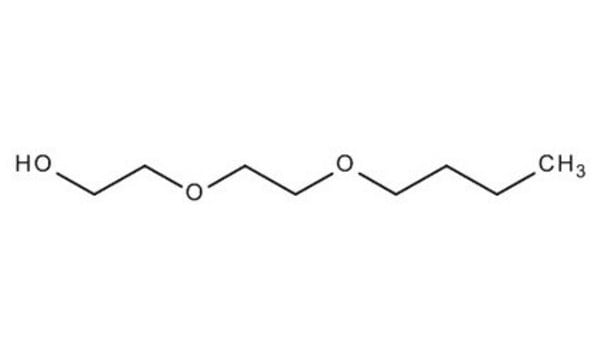90440
Triethylene glycol monobutyl ether
technical, ~70% (GC)
Synonym(s):
Butyltriglycol
Sign Into View Organizational & Contract Pricing
All Photos(1)
About This Item
Recommended Products
grade
technical
Assay
~70% (GC)
form
liquid
refractive index
n20/D 1.441
bp
265-350 °C (lit.)
density
0.990 g/mL at 20 °C (lit.)
SMILES string
OCCOCCOCCOCCCC
InChI
1S/C10H22O4/c1-2-3-5-12-7-9-14-10-8-13-6-4-11/h11H,2-10H2,1H3
InChI key
COBPKKZHLDDMTB-UHFFFAOYSA-N
Related Categories
Application
Triethylene glycol monobutyl ether (TEGMBE) can be used as a solvent:
It can also be used as a reactant in the preparation of polyether adducts of bis(1,1,1,5,5,5-hexafluoro-2,4-pentanedionato)barium.
- In the synthesis of superparamagnetic iron oxide nanoparticles by thermal decomposition method.
- in the removal of CO2 due to its solubilize CO2.
It can also be used as a reactant in the preparation of polyether adducts of bis(1,1,1,5,5,5-hexafluoro-2,4-pentanedionato)barium.
Signal Word
Danger
Hazard Statements
Precautionary Statements
Hazard Classifications
Eye Dam. 1
Storage Class Code
10 - Combustible liquids
WGK
WGK 1
Flash Point(F)
291.2 °F - closed cup
Flash Point(C)
144.0 °C - closed cup
Personal Protective Equipment
dust mask type N95 (US), Eyeshields, Gloves
Certificates of Analysis (COA)
Search for Certificates of Analysis (COA) by entering the products Lot/Batch Number. Lot and Batch Numbers can be found on a product’s label following the words ‘Lot’ or ‘Batch’.
Already Own This Product?
Find documentation for the products that you have recently purchased in the Document Library.
Customers Also Viewed
Use of triethylene glycol monobutyl ether in synthesis of iron oxide nanoparticles
Beyaz S, et al.
Journal of magnetism and magnetic materials, 361, 249-254 (2014)
Volatility by design. synthesis and characterization of polyether adducts of bis (1, 1, 1, 5, 5, 5-hexafluoro-2, 4-pentanedionato) barium and their implementation as metal- organic chemical vapor deposition precursors
Belot JA, et al.
Chemistry of Materials, 9(7), 1638-1648 (1997)
24883902
PubMed ID (for auto-filling citation data) null
Seo Woo Song et al.
Science advances, 7(13) (2021-03-26)
Pen drawing is a method that allows simple, inexpensive, and intuitive two-dimensional (2D) fabrication. To integrate such advantages of pen drawing in fabricating 3D objects, we developed a 3D fabrication technology that can directly transform pen-drawn 2D precursors into 3D
Solubilities of carbon dioxide in polyethylene glycol ethers
Henni A, et al.
The Canadian Journal of Chemical Engineering, 83(2), 358-361 (2005)
Our team of scientists has experience in all areas of research including Life Science, Material Science, Chemical Synthesis, Chromatography, Analytical and many others.
Contact Technical Service












